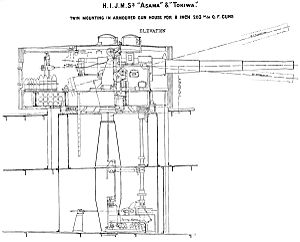| Asama-class cruiser | |
|---|---|
 Asama in 1900 | |
| Class overview | |
| Builders: | Armstrong Whitworth, United Kingdom |
| Operators: |
|
| Succeeded by: | Izumo-class cruiser |
| Built: | 1897–1899 |
| In commission: | 1899–1945 |
| Completed: | 2 |
| General characteristics | |
| Type: | Cruiser |
| Displacement: | 9,700 long tons (9,856 t) |
| Length: | 124.36 m (408 ft 0 in) |
| Beam: | 20.45 m (67 ft 1 in) |
| Draught: | 7.43 m (24 ft 5 in) |
| Propulsion: |
2 shaft VTE 18,000 ihp (13,000 kW) |
| Speed: | 21.5 knots (24.7 mph; 39.8 km/h) |
| Range: | 4,600 nmi (8,500 km) at 11.5 kn (13.2 mph; 21.3 km/h)[1] |
| Complement: | 726 |
| Armament: |
• 4 × 203 mm (8 in) guns |
| Armour: |
Main belt: 88–178 mm (3.5–7.0 in) Upper belt: 127 mm (5.0 in) Barbette, turret, casemate: 152 mm (6.0 in) Conning tower: 76–356 mm (3.0–14.0 in) [1] |
The two Asama class cruisers (浅間型装甲巡洋艦 Asama-gata sōkōjun'yōkan) were armored cruisers operated by the Imperial Japanese Navy. They participated in numerous actions during the Russo-Japanese War and in World War I.
They would be followed by the very similar Izumo-class cruisers.
Background[]
The Asama class armored cruisers were the first pair of six cruisers ordered from overseas shipyards after the First Sino-Japanese War as part of the "Six-Six Program" (six battleships-six cruisers). This program was intended to form the backbone of the Imperial Japanese Navy. Construction of the Asama-class ships began as a private venture by the British shipbuilder Armstrong Whitworth of Elswick for projected export business. It was fortuitous for the company that the Japanese navy had a specification which required only slight modifications to the initial design. At the time of their completion, the Asama-class cruisers were considered the fastest, most heavily armed and most armored cruisers in the world. However, extremely fast development of technology, weaponry and armor in this field of ship design meant that the supremacy of this design was short.
Design[]


The hull of the Asama class cruiser was a typical flush deck with high freeboard to improve seaworthiness. The design still came with a ram attached to the bow. The 45-caliber 203 mm main guns were mounted in twin gun turrets fore and aft. Each could fire a 113-kilogram (249 lb) shell at the rate of two per minute over a range of 18,000 metres (19,690 yd). The turrets were capable of 150 degree rotation left and right, and the guns could be elevated to 30 degrees. The secondary side-mounted 40-caliber, 152 mm rapid fire guns had a range of 10,000 yards (9,140 m), and could fire at the rate of five shells per minute (up to seven per minute for a very skilled gun crew).
Propulsion was by two vertical triple expansion steam engines, two shafts, with 12 boilers, yielding a speed of 21.5 knots and a range of 7,000 nautical miles (12,960 km) at 10 knots (19 km/h) based on a 1,409 ton[vague]
load of coal.
Ships in class[]
Two Asama class cruisers were purchased from Armstrong Whitworth. They proved to have the longest operational life of any vessels in the Imperial Japanese Navy. Both were scrapped after the end of World War II.
Ordered in 1897, launched 22 March 1898, and completed 18 March 1899, the Asama participated in the Boxer Rebellion, Russo-Japanese War and World War I. It later served as a training ship, and stripped of its weaponry, as a floating barracks. It survived World War II, and was scrapped in 1947.

The Japanese cruiser Tokiwa in 1905
Ordered in 1897, launched 6 July 1898, and completed 18 May 1899, the Tokiwa participated in the Russo-Japanese War and World War I. It later served as a training ship, and was then converted into a minelayer and subsequently saw service in the Pacific War. Beached after being damaged by an air attack on 9 August 1945, it was scrapped in 1947.
See also[]
| Wikimedia Commons has media related to Asama class armored cruisers. |
References[]
- Evans, David. Kaigun: Strategy, Tactics, and Technology in the Imperial Japanese Navy, 1887-1941. US Naval Institute Press (1979). ISBN 0-87021-192-7
- Howarth, Stephen. The Fighting Ships of the Rising Sun: The Drama of the Imperial Japanese Navy, 1895-1945. Atheneum; (1983) ISBN 0-689-11402-8
- Jane, Fred T. The Imperial Japanese Navy. Thacker, Spink & Co (1904) ASIN: B00085LCZ4
- Jentsura, Hansgeorg. Warships of the Imperial Japanese Navy, 1869-1945. Naval Institute Press (1976). ISBN 0-87021-893-X
- Schencking, J. Charles. Making Waves: Politics, Propaganda, And The Emergence Of The Imperial Japanese Navy, 1868-1922. Stanford University Press (2005). ISBN 0-8047-4977-9
- Chesneau, Roger (1979). Conway's All the World's Fighting Ships, 1860–1905.. Conway Maritime Press. ISBN 0-85177-133-5.
| |||||||||||
| ||||||||||||||||||||||||||
| ||||||||||||||||||||||||||||||||
The original article can be found at Asama-class cruiser and the edit history here.